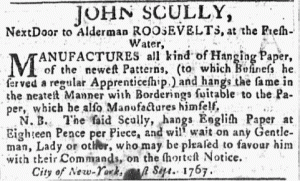What was advertised in a colonial American newspaper 250 years ago today?

“All kind of Hanging Paper, of the newest Patterns.”
Prior to the Revolution, many Americans decorated their homes with wallpaper (known in the eighteenth century as “Hanging Paper” or paper hangings) imported from Great Britain. That trade temporarily ceased during the war, but Americans resumed acquiring wallpaper (and many other consumer goods) from England almost as soon as the Treaty of Paris brought an end to hostilities in 1783. At that time, the new nation set its own trade policies and, no longer inhibited by restrictions put in place by Parliament, increased the flow of goods from other European nation-states. Some advertisers promoted French paper hangings as alternatives to any from Britain in the 1780s and 1790s.
Yet importers did not provide Americans sole access to wallpaper, either before or after the Revolution. Domestic manufacturers incorporated “Buy American” appeals into their marketing efforts in the final decades of the eighteenth century. Some even lobbied for tariffs on imported paper hangings in order to bend competition in the marketplace to their own advantage.[1]
Advertisements from the late colonial period reveal that production of wallpaper commenced in America prior to the Revolution. John Scully, for instance, made, sold, and installed “Hanging Paper” and “Borderings suitable to the Paper” in New York in the 1760s. Realizing that many prospective clients might consider imported wallpaper superior for a variety of reasons, he advanced multiple appeals to convince readers of the New-York Gazette to give him a chance. He stressed that he “MANUFACTURES all kind” of wallpaper, implying he offered the same range of choice as his competitors who imported from England. He underscored that his wares followed “the newest Patterns,” reassuring potential customers that they did not have to purchase wallpaper produced on the other side of the Atlantic in order to keep up with fashions set in the cosmopolitan center of the empire. Lest potential clients assume that American manufacturers could not produce wallpaper of the same quality as the English imports, Scully proudly stated that he had “served a regular Apprenticeship” in that business. Customers could depend on his skill.
John Scully realized that his livelihood depended on successfully competing with shopkeepers and paperhangers who sold and installed wallpaper imported from England. To do so, he made appeals to choice, fashion, and his own training to convince consumers to purchase from him.
**********
[1] For more on the marketing of paper hangings after the Revolution, see Carl Robert Keyes, “A Revolution in Advertising: ‘Buy American’ Campaigns in the Late Eighteenth Century,” in Creating Advertising Culture: Beginnings to the 1930s, vol. 1, We Are What We Sell: How Advertising Shapes American Life … And Always Has, ed. Danielle Sarver Coombs and Bob Batchelor (Praeger, 2014), 1-25.

